[social_warfare]
Welcome to the wild world of Africa’s most venomous snakes – a slithering lineup that’s as fascinating as it is terrifying.
Picture this: you’re trekking through the lush African savannah or the dense jungles, and out of nowhere, you encounter a creature that could end your adventure in a heartbeat. These snakes aren’t just part of the scenery; they’re nature’s most efficient predators, equipped with venom potent enough to drop an elephant (or a very unlucky human).
This isn’t just a list of dangerous reptiles; it’s your ultimate guide to the deadliest snakes in Africa. We’re taking a journey through the habitats and hunting grounds of these formidable creatures, unveiling their lethal secrets and why they deserve both our respect and caution.
From the lightning-fast strikes of the Black Mamba to the stealthy tree-dwelling Boomslang, we’ve got every spine-chilling detail covered.
Ready to meet the ten deadliest snakes in Africa? Let’s slither right in.
The 10 Deadliest Snakes in Africa:
1. Black Mamba (Dendroaspis polylepis)
The real-life nightmare that moves faster than your worst hangover. If there’s one snake that commands both fear and respect in Africa, it’s the Black Mamba.
Known for its speed, aggression, and potent venom, the Black Mamba is the stuff of legends – and for good reason.
Sleek and sinuous, the Black Mamba isn’t actually black. Its name comes from the dark, inky color inside its mouth, which it displays as a warning before striking.
This snake can grow up to 14 feet long, making it one of the longest venomous snakes in Africa. Its coloration varies from grey to dark brown, blending seamlessly into the African landscape.
Venom
When it comes to venom, the Black Mamba doesn’t play around. Its neurotoxic venom attacks the nervous system, causing paralysis, respiratory failure, and, if untreated, death.
A single bite delivers enough venom to kill 10 adult humans, and the onset of symptoms is terrifyingly swift.
Victims can start experiencing symptoms within 30 minutes, with death occurring in as little as 7 hours without treatment.
This snake prefers to avoid confrontation, but when cornered, it becomes highly aggressive and strikes repeatedly.
Where to Find Them
Black Mambas are found across sub-Saharan Africa, favoring savannas, rocky hills, and open woodlands.
They’re shy creatures, often found in termite mounds, hollow trees, or abandoned burrows.
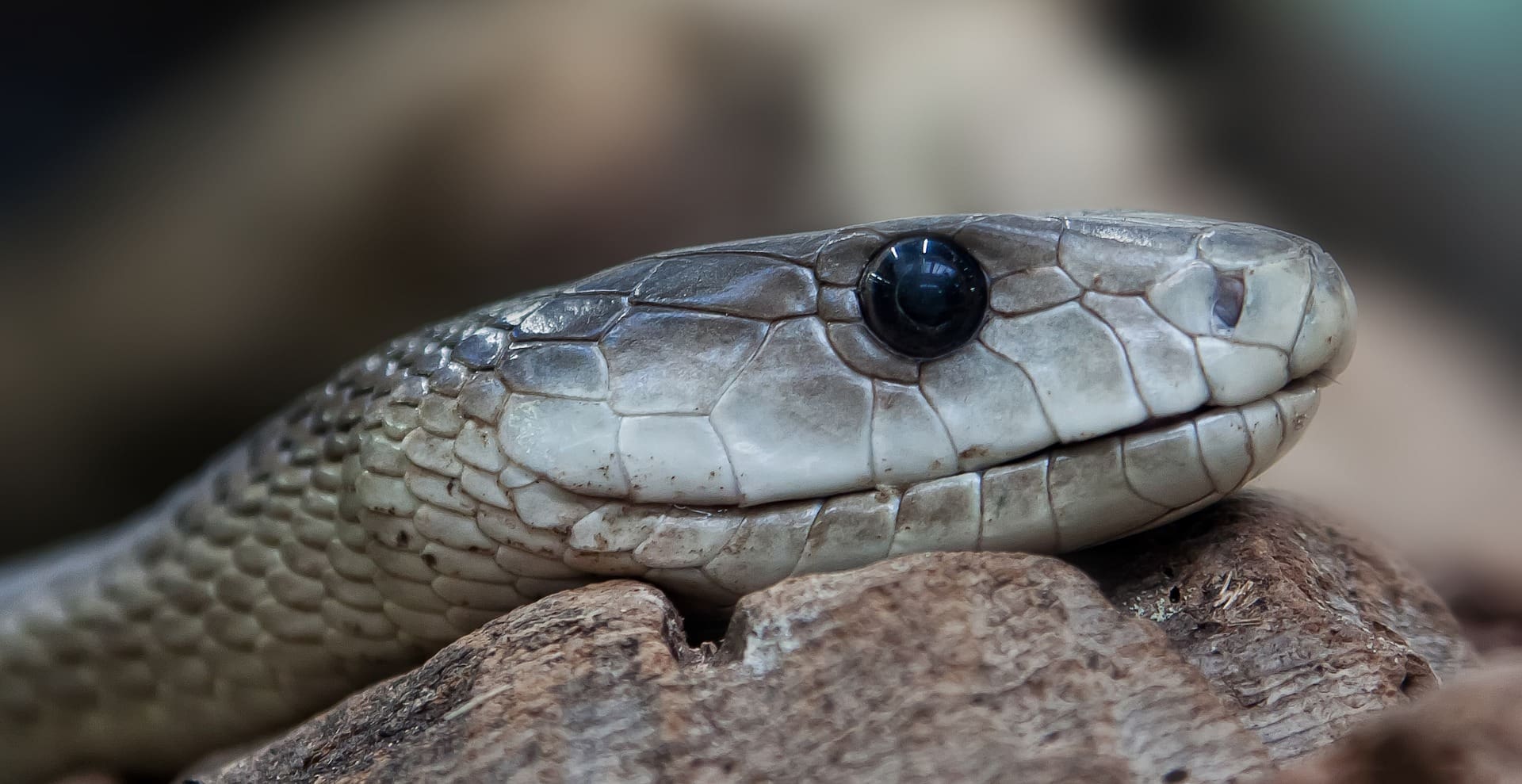
2. Puff Adder (Bitis arietans)
It’s like stepping on a landmine, except it hisses.
The Puff Adder is one of the most widespread and dangerous snakes in Africa, responsible for more snakebite fatalities than any other snake on the continent.
Stocky and sluggish, the Puff Adder relies on its impressive camouflage to ambush prey. It can grow up to 6 feet long and has a thick, muscular body with a beautiful yet deadly zigzag pattern running along its back.
This pattern helps it blend into the underbrush, making it nearly invisible until it’s too late.
Venom
The Puff Adder’s venom is cytotoxic, which means it destroys cells and tissues.
A bite from this snake causes immense pain, swelling, and tissue damage. Without prompt medical treatment, the venom can lead to necrosis, where the affected tissue dies and starts to rot, often requiring amputation.
The Puff Adder is responsible for the most snakebite fatalities in Africa. Its tendency to lie still and rely on camouflage means it’s often accidentally stepped on, triggering a defensive strike.
Where to Find Them
Puff Adders are found throughout sub-Saharan Africa, from open grasslands to forests. They’re highly adaptable and can thrive in various environments, including near human settlements.
When walking through areas where Puff Adders might be present, always wear sturdy boots and watch your step.
Use a walking stick to gently probe the ground ahead of you. If you encounter a Puff Adder, give it plenty of space and back away slowly.

READ NEXT: THE MOST DANGEROUS ANIMALS IN AFRICA
3. Cape Cobra (Naja nivea)
A beauty with a deadly kiss. The Cape Cobra is as vibrant as it is venomous, known for its striking yellow or brown coloration and potent neurotoxic venom.
This snake is a true embodiment of danger wrapped in beauty, making it one of Africa’s most intriguing yet perilous creatures.
The Cape Cobra can range in color from bright yellow to dark brown, and sometimes even black, depending on its geographic location.
It’s a relatively slender snake, growing up to 5 feet long, and is often seen with its characteristic hood flared, a warning sign to would-be predators or threats.
Venom
Cape Cobra venom is neurotoxic, meaning it attacks the nervous system. A bite from this snake can lead to respiratory failure and death within hours if not treated promptly.
The venom works fast, causing symptoms like difficulty breathing, paralysis, and even coma.
Where to Find Them
Cape Cobras are primarily found in southern Africa, particularly in South Africa, Namibia, and Botswana. They inhabit a variety of environments, from arid deserts to moist savannas, and are often seen near human settlements.
The Cape Cobra is often found in urban areas, including vineyards and farms in South Africa. This proximity to human activity increases the chances of encounters, making awareness and caution crucial.
If you’re exploring areas where Cape Cobras might be present, be mindful of your surroundings. Avoid tall grass and be cautious when turning over rocks or logs.
If you see a Cape Cobra, do not attempt to handle or provoke it. Back away slowly and give it plenty of space to escape.
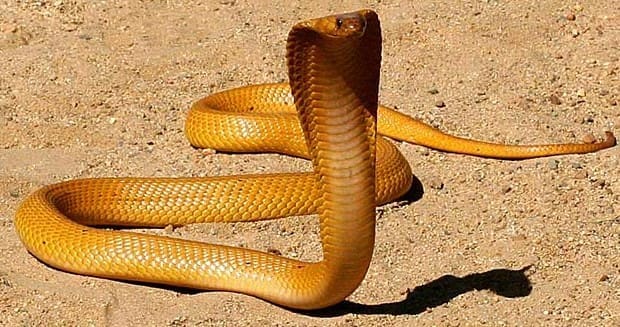
4. Gaboon Viper (Bitis gabonica)
The heavy hitter with the longest fangs in the snake world.
The Gaboon Viper is a true masterpiece of nature, combining beauty with sheer power and lethality.
This snake is not just one of Africa’s deadliest but also one of its most visually striking.
The Gaboon Viper boasts an intricate pattern of browns, purples, and pinks, providing perfect camouflage in the forest floor’s leaf litter.
It’s a hefty snake, with adults reaching lengths of up to 6 feet and weighing up to 20 pounds. Its broad head and distinctive horns on its snout make it easily recognizable.
Venom
The Gaboon Viper’s venom is hemotoxic, causing massive tissue damage, pain, and swelling. With the longest fangs of any venomous snake, measuring up to 2 inches, it delivers a substantial dose of venom in a single bite.
This can result in intense pain, swelling, and even systemic effects like blood clotting disorders and organ failure if not treated promptly.
The Gaboon Viper has the highest venom yield of any snake, delivering up to 600 mg of venom in a single bite.
Despite its deadly potential, it’s known for its calm demeanor and tendency to remain motionless, relying on its camouflage to avoid detection.
Where to Find Them
Gaboon Vipers are found in the rainforests and savannas of West and Central Africa. They prefer humid, forested areas where their camouflage allows them to blend seamlessly with the leaf litter on the forest floor.
When trekking through areas inhabited by Gaboon Vipers, stay on clear paths and avoid walking through dense underbrush. Always wear sturdy boots and be cautious when stepping over logs or rocks.
If you encounter a Gaboon Viper, do not approach it. Give it plenty of space and move away slowly.

5. Boomslang (Dispholidus typus)
Don’t let the name fool you – it’s not a slang for ‘harmless’. The Boomslang is an arboreal predator with a lethal bite, known for its ability to blend into the foliage and strike with deadly precision.
The Boomslang, which translates to “tree snake” in Afrikaans, is a master of disguise in the treetops. It can grow up to 6 feet long, with large eyes and a slender body that ranges in color from bright green to brown or even black.
This coloration helps it blend perfectly into its arboreal habitat, making it nearly invisible to both prey and potential threats.
Venom
The Boomslang’s venom is hemotoxic, causing internal bleeding and disrupting blood clotting. Victims may experience severe hemorrhaging, including bleeding from mucous membranes, muscles, and internal organs.
The effects can be delayed, sometimes taking several hours to manifest, which can be misleading and dangerous.
The Boomslang’s fangs are located at the back of its mouth, a feature known as opisthoglyphous dentition. Despite this, it can open its jaws incredibly wide to deliver a bite.
Its venom was once thought to be harmless to humans until the tragic death of herpetologist Karl Schmidt in 1957, which brought its deadly potential to light.
Where to Find Them
Boomslangs are found throughout sub-Saharan Africa, in both forested and savanna regions. They are highly arboreal, spending most of their time in trees and bushes, hunting birds, chameleons, and small mammals.
When exploring areas where Boomslangs might reside, be extra cautious when moving through trees or shrubs.
Look above and around you, and avoid disturbing branches where these snakes might be resting. If you spot a Boomslang, admire it from a distance and avoid any sudden movements.

6. Mozambique Spitting Cobra (Naja mossambica)
This cobra doesn’t just bite – it spits! The Mozambique Spitting Cobra is notorious for its unique defensive behavior, making it a formidable opponent in the wild.
The Mozambique Spitting Cobra is a relatively small cobra, growing up to 4 feet in length. Its coloration ranges from olive to dark brown, with a pale underbelly.
This snake is highly adaptable, often found in a variety of habitats, including savannas, forests, and even near human settlements.
Venom
The venom of the Mozambique Spitting Cobra is both cytotoxic and neurotoxic. When it bites, the venom causes severe pain, swelling, and tissue damage.
However, what sets this snake apart is its ability to spit venom up to 3 meters (about 10 feet) away.
If the venom gets into the eyes, it can cause intense pain and temporary or permanent blindness. Immediate washing of the eyes is crucial to mitigate damage.
Mozambique Spitting Cobras can accurately spit venom at the eyes of their aggressors, a defensive tactic that allows them to deter threats without engaging in direct combat.
This spitting behavior is often accompanied by a dramatic hood display and hissing.
Where to Find Them
These cobras are found across southeastern Africa, including countries like Mozambique, Zimbabwe, Botswana, and South Africa.
They thrive in diverse environments, from coastal regions to inland savannas and woodlands.
When in areas inhabited by Mozambique Spitting Cobras, always wear protective eyewear if you’re working or walking through tall grass or shrubs.
If you encounter a cobra, remain calm and avoid sudden movements. If it starts to rear up and spread its hood, back away slowly and cover your eyes to protect them from venom spray.
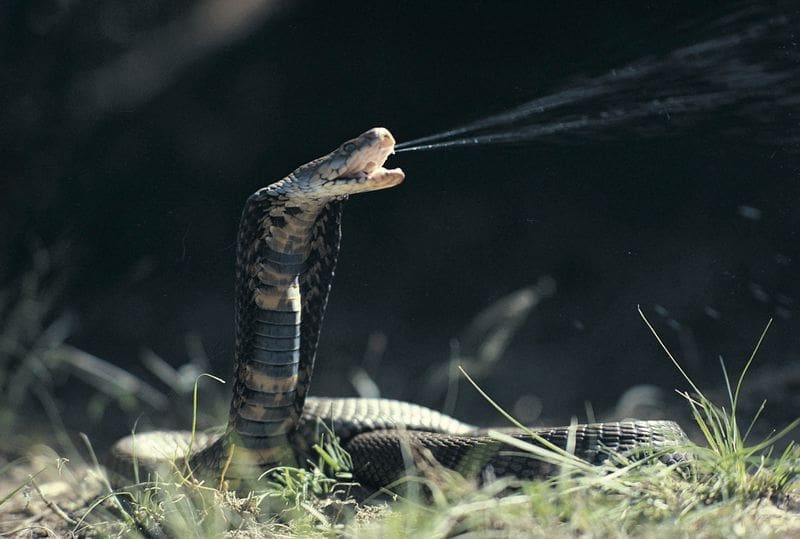
7. Egyptian Cobra (Naja haje)
Pharaohs weren’t the only deadly thing in ancient Egypt.
The Egyptian Cobra is a snake steeped in history, with a venomous bite that has claimed its place in both legend and reality.
Naja haje is a large and robust snake, capable of reaching lengths of up to 8 feet. Its coloration varies from brown to almost black, with a broad head and characteristic hood that it flares when threatened.
This snake is both elegant and intimidating, a fitting symbol for its storied past.
Venom
The venom of the Egyptian Cobra is predominantly neurotoxic, attacking the nervous system and causing paralysis, respiratory failure, and potentially death if untreated.
Symptoms of envenomation can appear rapidly, including dizziness, blurred vision, and difficulty breathing.
Cleopatra’s alleged method of suicide was an Egyptian Cobra bite, a tale that has cemented this snake’s place in history and popular culture.
It’s also often depicted in ancient Egyptian art, symbolizing royalty and divine authority.
Where to Find Them
Egyptian Cobras are found throughout North Africa, from the Nile Valley to the savannas and deserts of the region. They are adaptable snakes, inhabiting a range of environments including agricultural lands and even urban areas.
When traveling in areas where Egyptian Cobras are found, be cautious around abandoned buildings, piles of debris, and rock outcrops where they might take shelter.
If you see an Egyptian Cobra, do not approach it. Slowly and calmly back away, giving it space to retreat.

8. West African Carpet Viper (Echis ocellatus)
The small but deadly resident of West Africa. The West African Carpet Viper may not have the imposing size of some of its counterparts, but it more than makes up for it with its highly toxic venom and aggressive nature.
The West African Carpet Viper is a relatively small snake, typically growing to about 2 feet in length. Its coloration and pattern vary, but it generally features a series of dark, circular markings (ocelli) along its back, which provide excellent camouflage in its native habitat.
Its body is stout, and it has a distinctive head shape with large, prominent eyes.
Venom
The venom of the West African Carpet Viper is highly hemotoxic, causing severe internal bleeding, pain, and swelling.
It disrupts blood clotting, leading to prolonged bleeding from the bite site and other areas of the body.
This snake is responsible for more snakebite deaths in West Africa than any other species due to its potent venom and close proximity to human populations.
Despite its small size, the West African Carpet Viper is considered one of the most dangerous snakes in Africa due to its aggressive nature and the severity of its venom.
It is known to be highly irritable and will strike repeatedly if threatened.
Where to Find Them
West African Carpet Vipers are found throughout West Africa, particularly in dry savannas and arid regions. They are also common in areas with agricultural activities, where they often come into contact with humans.
When traveling in West Africa, be cautious when walking through dry, grassy areas or agricultural fields.
Always wear sturdy boots and watch where you step. If you encounter a West African Carpet Viper, remain calm and slowly back away. Seek immediate medical attention if bitten, as prompt treatment is crucial.

9. Green Mamba (Dendroaspis angusticeps)
Green means go – for the kill. The Green Mamba is a slender, agile snake that is as beautiful as it is deadly.
Known for its striking coloration and potent venom, this snake is a true testament to the deadly allure of nature.
The Green Mamba is a vibrant, emerald-green snake that can grow up to 6.5 feet long. Its smooth, slender body and large eyes give it a sleek appearance.
This snake is primarily arboreal, spending most of its time in trees and bushes, where its green coloration provides excellent camouflage.
Venom
The venom of the Green Mamba is neurotoxic, causing rapid onset of symptoms such as dizziness, difficulty breathing, and paralysis.
Without prompt medical treatment, a bite from this snake can be fatal. The venom disrupts the nervous system, leading to respiratory failure and, ultimately, death.
Unlike its more aggressive cousin, the Black Mamba, the Green Mamba is relatively shy and will often flee from humans if given the chance.
However, if cornered or threatened, it can deliver a swift and deadly bite.
Where to Find Them
Green Mambas are found along the eastern coast of Africa, from Kenya to South Africa. They thrive in coastal forests, woodland areas, and even in suburban gardens, where they hunt birds, rodents, and other small animals.
When exploring areas where Green Mambas are found, be cautious when moving through dense vegetation or climbing trees.
Always watch your surroundings and avoid disturbing branches or foliage where these snakes might be hiding. If you encounter a Green Mamba, remain calm and slowly back away.
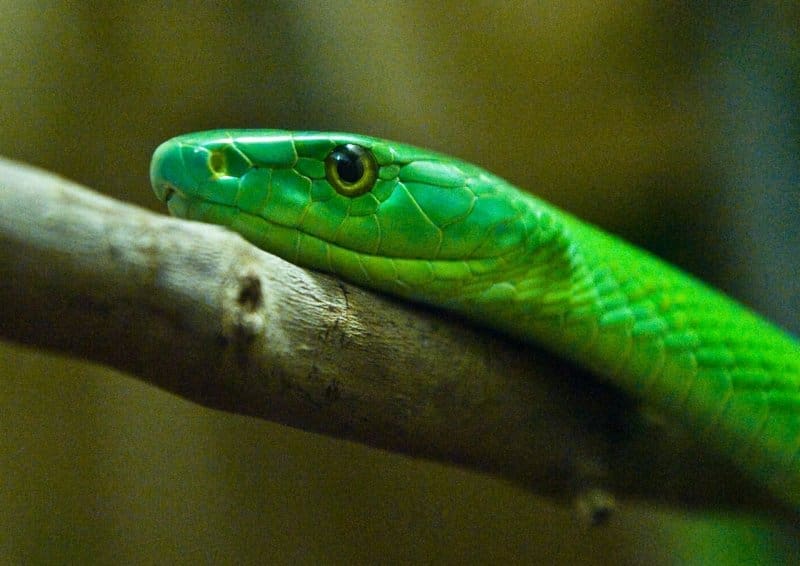
10. Forest Cobra (Naja melanoleuca)
The ninja of the African jungles. The Forest Cobra is a large, agile snake known for its speed and potent venom, making it a formidable predator in the African wilderness.
The Forest Cobra is one of the largest true cobras, capable of reaching lengths of up to 10 feet.
Its coloration varies widely, from black and white bands to solid black or brown, depending on its region.
This snake is highly adaptable, equally comfortable on the ground, in water, or climbing trees.
Venom
The venom of the Forest Cobra is neurotoxic, causing rapid onset of symptoms such as difficulty breathing, muscle weakness, and paralysis.
A bite from this snake can be fatal if not treated promptly, as the venom disrupts the nervous system, leading to respiratory failure.
Forest Cobras are excellent swimmers and climbers, often found near water bodies or high up in trees.
Their versatility makes them one of the most adaptable and wide-ranging cobras in Africa.
Where to Find Them
Forest Cobras are found throughout Central and West Africa, inhabiting rainforests, savannas, and mangroves. They are highly adaptable and can thrive in a variety of environments, from dense jungles to open woodlands.
When traveling through areas where Forest Cobras are present, stay alert and watchful, especially near water bodies and dense vegetation.
Avoid reaching into crevices or climbing trees where these snakes might be hiding. If you encounter a Forest Cobra, do not panic – back away slowly and give it plenty of space to escape.
11. Rinkhals (Hemachatus haemachatus)
Also known as the ring-necked spitting cobra, the rinkhals is not a true cobra despite its flared hood and threatening upright posture.
This species is endemic to Southern Africa, and is found only in South Africa and eastern Zimbabwe, and is one of few snake species that gives birth to live young.
The rinkhals prefers grassland and fynbos habitats and is common around wetland areas. It preys predominantly on toads and other small amphibian and reptile species.
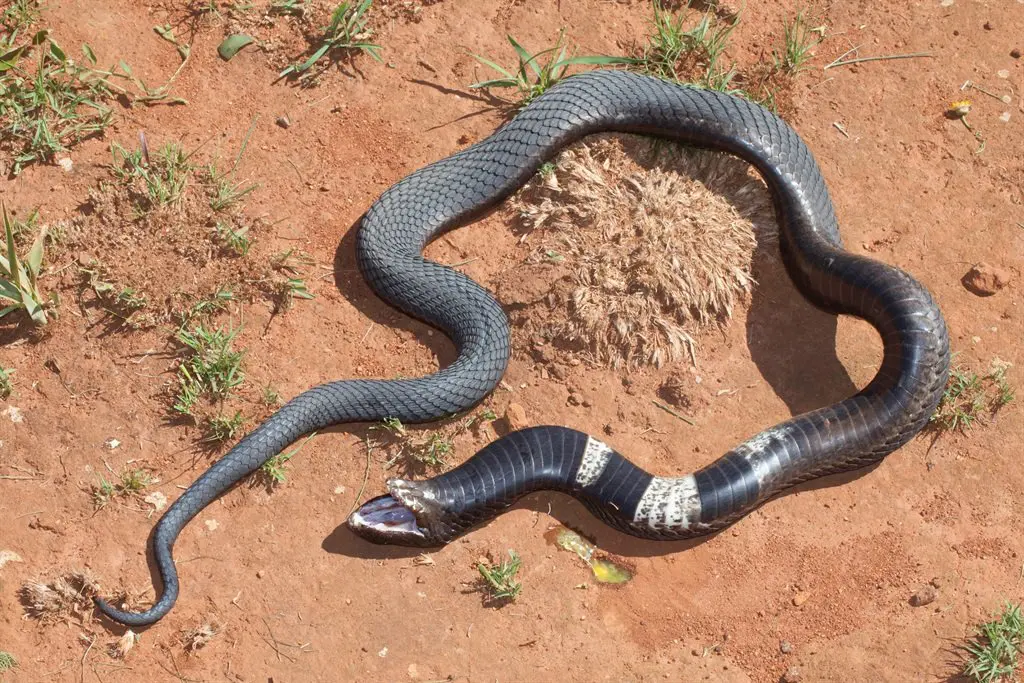
Reaching an average length of 1.2 metres (4 ft) their colour can vary greatly, but the light-coloured bands are always distinguishable.
Rinkhals possess a number of tricks in their arsenal. They are able to spit venom up to 2.5 metres and are also known to play dead when threatened. Humans have been known to pick up what they think is a dead snake and be met with a nasty surprise.
Despite this and its potent cytotoxic venom, human attacks and fatalities are rare.
What to Do in the Event of a Snake Bite
If you or someone you know are bitten by a snake in Africa, here’s what you should do according to the African Snakebite Institute:
- Get the victim to a hospital immediately. Call ahead to notify hospital staff about the victim’s condition, the location of the bite, and any information regarding the species of the snake. If you are unsure then take a picture if possible, but be sure to keep a safe distance.
- While waiting for an ambulance or transporting the victim to hospital, keep them as calm and still as possible to slow the spread of venom. If you can, get them to lie down and elevate the bitten area slightly above heart level.
- If the bite occurred on the hand, arm, foot, or lower leg, remove any tight jewelry, clothing, or shoes to allow for inevitable swelling.
- If you suspect that the victim was bitten by a mamba or Cape cobra, try to apply a pressure bandage to the affected area. In order not to waste time getting to the hospital, this should be done in transit.
- If the victim is having difficulty breathing, or stops breathing completely, begin mouth-to-mouth resuscitation.
- Do not try to remove the venom by cutting or sucking the wound. Similarly, you should not apply electric shock therapy, tourniquets, ice, hot water, or any other medication. Anti-venom should only be administered by a professional in a hospital environment.
Poison Vs Venom
When it comes to dangerous substances produced by animals, the terms “poison” and “venom” are often used interchangeably. However, they refer to different mechanisms of delivering their toxic effects. Understanding the distinction is crucial, especially when discussing creatures like snakes.
Definition: Poison is a toxic substance that can cause harm if ingested, inhaled, or absorbed through the skin.
- Delivery Method: Poisons typically enter the body passively. This can happen through various means such as touching, eating, or breathing in the substance.
- Examples: Poisonous animals include dart frogs and certain species of fish, like the pufferfish. These creatures often carry toxins on their skin or within their tissues. For instance, touching or consuming a poisonous frog can introduce toxins into your system, leading to illness or even death.
Characteristics:
- Poisons are often used by animals as a defense mechanism to deter predators.
- The primary way to be affected by poison is through contact or consumption.
Definition: Venom is a toxic substance that is actively injected into another organism through specialized anatomical structures, such as fangs, stingers, or spines.
- Delivery Method: Venoms are delivered through bites, stings, or other forms of injection directly into the body of the victim.
- Examples: Venomous animals include snakes (like the Black Mamba and Puff Adder), spiders (such as the Black Widow), and scorpions. These creatures have specialized organs to produce and deliver venom efficiently.
Characteristics:
- Venoms are typically used for predation (to immobilize or kill prey) or for defense.
- The effects of venom can vary widely, including neurotoxins that affect the nervous system, hemotoxins that damage blood cells and tissues, and cytotoxins that destroy cells.
Cover image: Gaboon Viper – Paul Starosta/Getty Images
